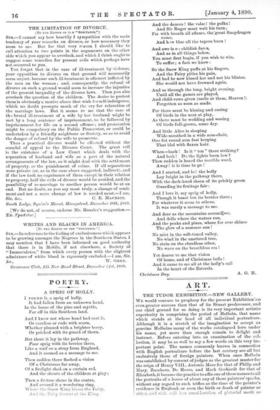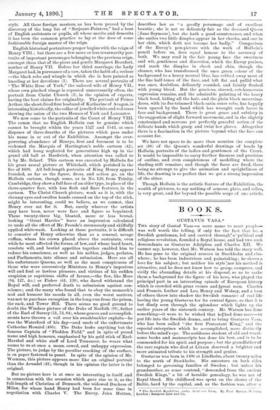ART.
THE TUDOR EXHIBITION.—NEW GALLERY. WE would venture to prophesy for the present Exhibition-are even greater success than that of its Stuart predecessor, and our chief ground for so doing is its very important artistic- superiority in comprising the period of Holbein, that name which stands at the head of all individual portraiture._ Although it is a stretch of the imagination to accept as. genuine Holbeins many of the works catalogued here under his name, yet more than enough remain to delight and instruct. Before entering into an examination of the col- lection, it may be as well to say a few words on this very im- portant point. The names commonly known in connection with English portraiture before the last century are all but exclusively those of foreign painters. When once Holbein was established by consent of judges as the greatest master for- the reign of Henry VIII., Antonio More for that of Philip and Mary, Zucchero, De Heere, and Mark Gerhardt for that of Elizabeth, it became the practice to affix one of these names to all the portraits of a house of about any of these painters' epochs, without any regard to such trifles as the time of the painter's residence in England, or even the birth or death of painter or sitter, and with still leas consideration of pictorial merit or-
style. All these foreign masters, as has been proved by the discovery of the long list of " Serjeant-Painters," had a host of English assistants or pupils, all whose merits and demerits it has been the common practice to lay at the door of some fashionable foreign master of the reign.
English historical portraiture proper begins with the reign of Henry VIII. ; but there are a few more or less trustworthy por- traits of important personages belonging to the previous reign, amongst them that of the pions and gentle Margaret Beaufort, mother of Henry VII. Before her third marriage, the Lady Margaret had, in pursuance of a vow, taken the habit of a recluse —the black robe and wimple in which she is here painted as kneeling at her devotions (1). There are several portraits of " The White Rose of York," the unloved wife of Henry VII., whose own pinched visage is repeated unnecessarily often, the portrait from Christ Church (3), in the opinion of experts, having the best claims for originality. The portrait of Prince Arthur, the short-lived first husband of Katharine of Aragon, is interesting historically, the collar of jewelled white and red roses showing the union of the two Houses of York and Lancaster.
We now come to the portraits of the Court of Henry VIII. The canon that no English Holbein can be genuine which cannot be brought within the years 1527 and 1543, at once disposes of three-fourths of the pictures which pass under his name in or out of the Exhibition. Amongst the over- powering abundance of Henrys, first and foremost is to be reckoned the Marquis of Hartington's noble cartoon (42), which had hung neglected for generations high up in the grand old hall at Hardwick, when attention was called to it by Mr. Scharf. This cartoon was executed by Holbein for his great mural picture at Whitehall, which perished in the fire of 1698. All full-length portraits of King Henry appear founded, as far as the figure, dress, and action go, on the Holbein cartoon, though some, as in No. 128, from Trinity, Cambridge, they show a full face of an older type, in place of the three-quarter face, with less flesh and finer features, in the cartoon. The Christ Church picture, weak as it is, with the rheumy eyes and swollen hands crossed on the top of the stick, might be interesting, could we believe, as we cannot, that Henry ever sat for it. But, surely whoever the artists may have been, never were face and figure so bepainted. These twenty-three big, bloated, more or less brutal- looking " Great Harries " leave an impression calculated to undo all the effect of Mr. Froude's strenuously and skilfully applied whitewash. Looking at these portraits, it is difficult to conceive of Henry otherwise than as a sensual, savage ruffian, whom his crown placed above the restraints, even while he most affected the forms, of law, and whose hard heart, resolute will, and bestial appetites together enabled him to reduce his conscience, as well as his nobles, judges, prelates, and Parliaments, into silence and submission. Here are all his unfortunate Queens, as well as the most conspicuous of those who were successively Ministers to Henry's imperious will and foul or lawless pleasure, and victims of his sudden suspicion or capricious shifts of favour,—the few, like More (94, 127, &c.) or Fisher (61, 138), who dared withstand the Royal will, and preferred death to submission against - con- science ; and the many who found that to obey the monarch's nod and humour his moods in all, even the worst matters, was not to purchase exemption in the long-run from the prison, the rack, and Tower Hill. There seems no good ground to doubt the Windsor picture of the Duke of Norfolk (91), father of the Earl of Surrey (51, 73, 84), whose graces and accomplish- ments have thrown a veil over his swashbuckler exploits—he was the Waterford of his day—and uncle of the unfortunate Catherine Howa'rd (495). The Duke looks anything but the famous Captain of " Flodden Field," and in spite of proud name and high honours, emphasised by his gold stick of Earl- Marshal and white staff of Lord Treasurer, he wears what seems to us at once a mean, cowed, and unhappy expression. The picture, to judge by the peculiar cracking of the surface, is on paper fastened to panel. In spite of the opinion of Mr. Wornum, this picture appears more like an original portrait than the Arundel (41), though in his opinion the latter is the original.
But no picture here is at once so interesting in itself, and in connection with the occasion which gave rise to it, as the full-length of Christina of Denmark, the widowed Duchess of Milan, for whose hand Henry bad been for some time in negotiation with Charles V. The Envoy, John Hutton, describes her as " a goodly personage and of excellent beautie ; she is not so delicately fair as the deceased Queen [Jane Seymour], but she hath a good countenance, and when she smiles two little dimples appear in her cheeks, and one in her chin, which doth not become her badly." Comparison of the Envoy's pen-picture with the work of Holbein's pencil before us, does equal honour to the accuracy of both. We may read in the fair young face the sweetness and wit, gentleness and discretion, which the Envoy praises, and mark the dimples in cheek and chin, though the cleaner, who has transformed the once green colour of the background to a heavy neutral blue, has rubbed away most of the fine half-tones of the face, and left flat and pallid what was once, doubtless, delicately rounded, and faintly flushed with young blood. But the gracious, shrewd, sub-humorous expression remains, and the admirable painting of the heavy black hood, hiding all the hair, and the plain black mourning- dress, with its fur-trimmed black-satin outer robe, has happily been spared by the hand which has wrought such havoc in face and background. There is great grace and subtlety in the suggestion of slight forward movement, and in the slightly constrained and nervous yet perfectly graceful action of the delicate hands which grasp and twist her gloves. Altogether there is a fascination in the picture beyond what the face can account for.
We have not space to do more than mention the complete set (88) of the Queen's wonderful drawings of heads by Holbein, portraits of the ladies and gentlemen of the Court. It would be impossible to carry further fineness and precision of outline, and even completeness of modelling where the shading still remains; and though the faces are fixed, there being no attempt to give the animation and sprightliness of life, the drawing is so perfect that we get a strong impression of the sitter.
Though Holbein is the artistic feature of the Exhibition, the wealth of pictures, to say nothing of armour, plate, and relics, is very great, and far beyond the possible scope of one article.















































 Previous page
Previous page